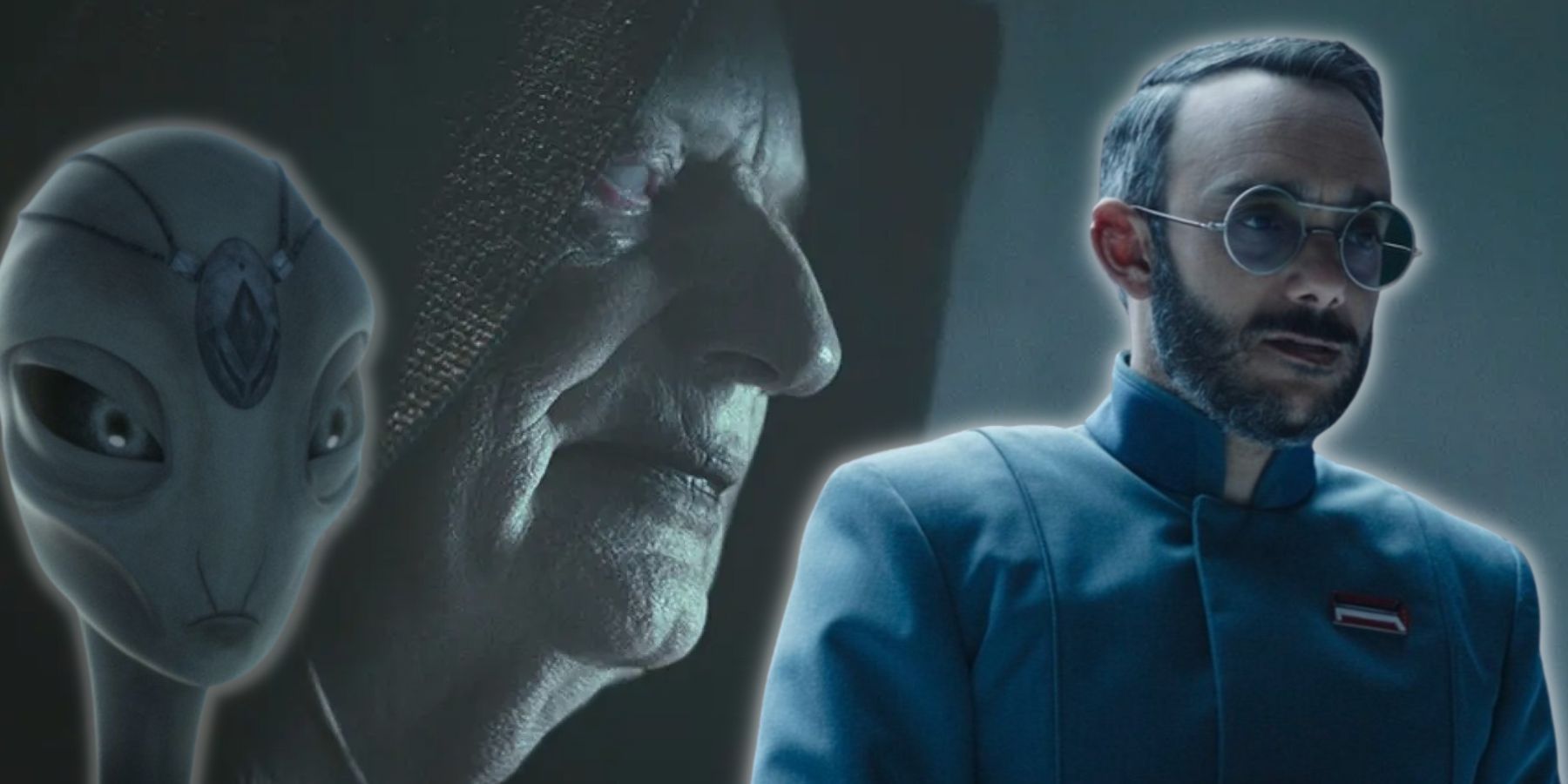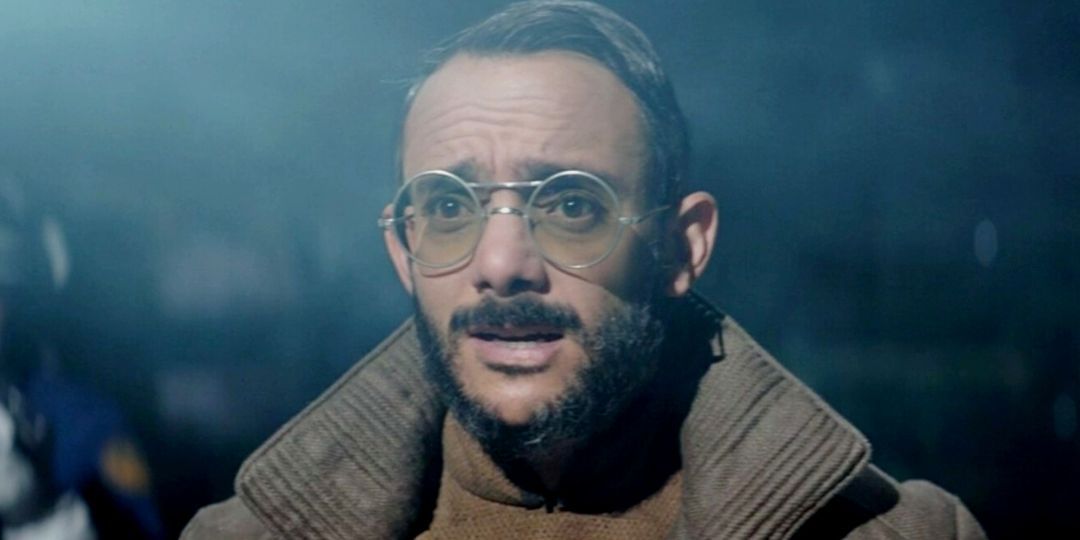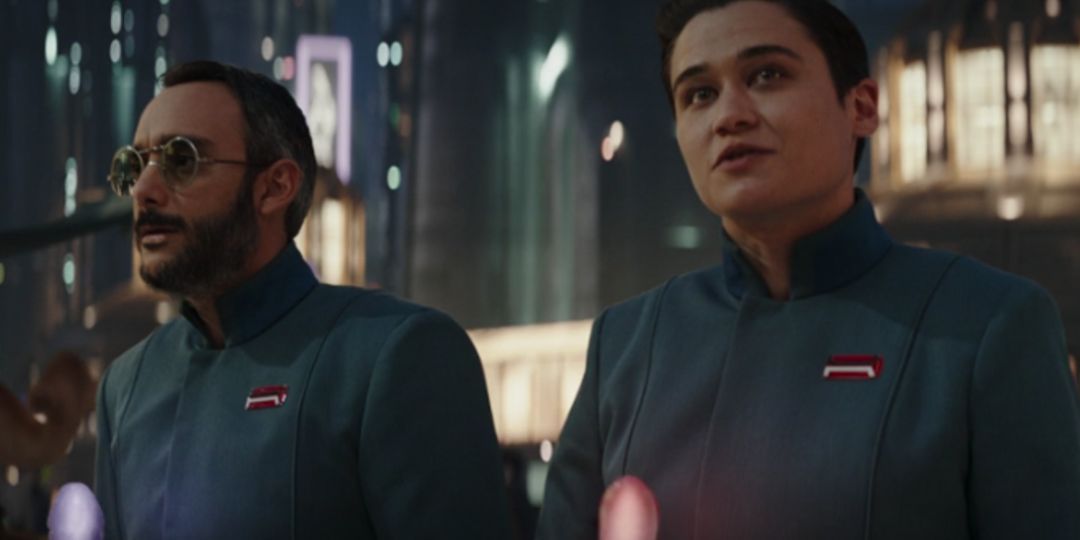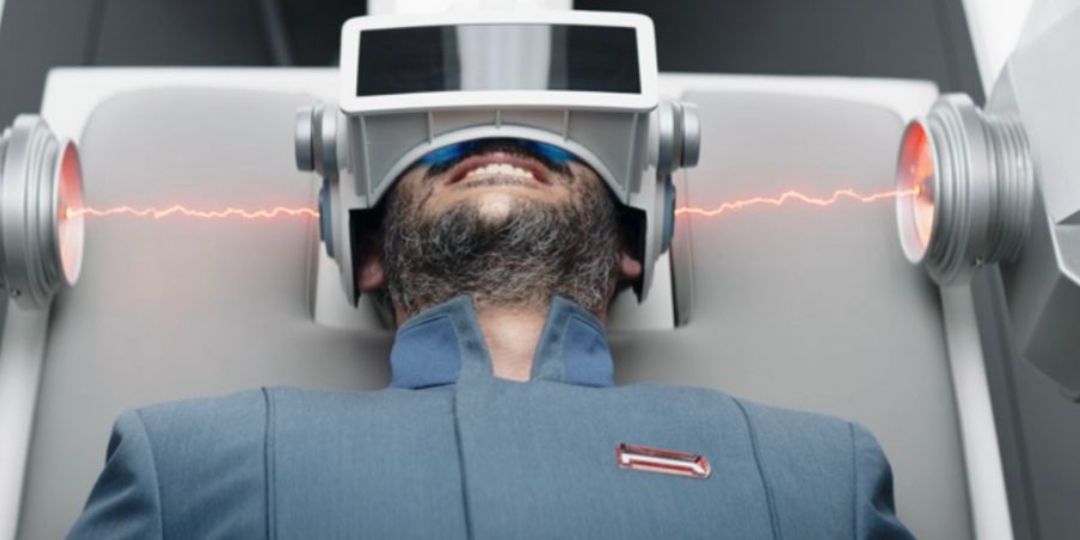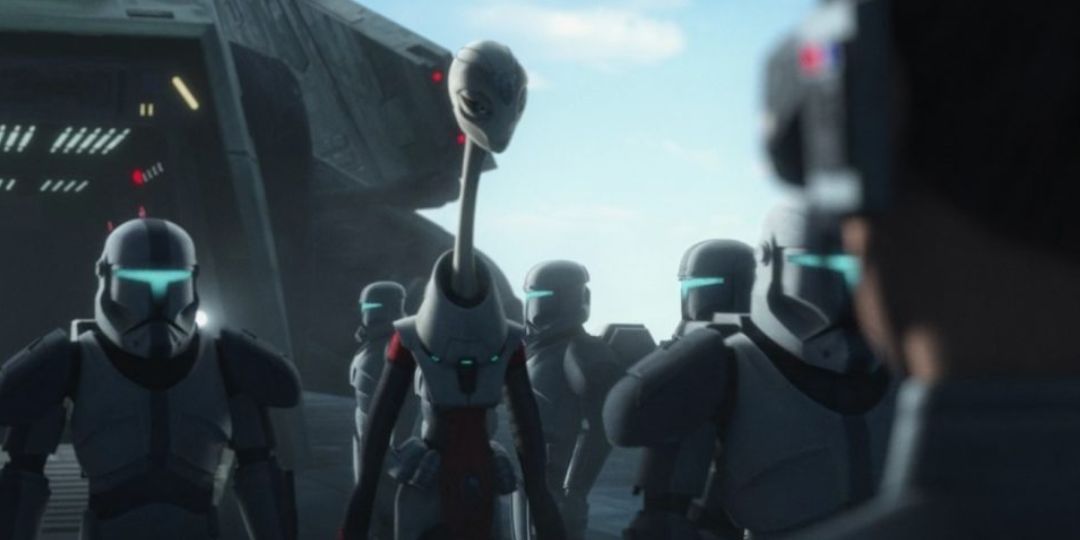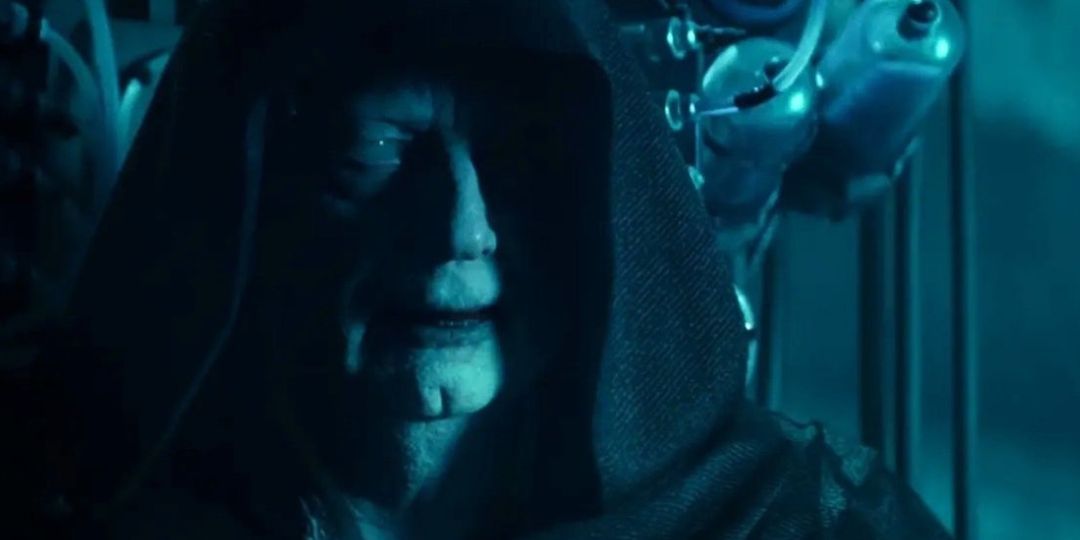The first season of The Mandalorian introduced fans to some memorable characters. Aside from Din Djarin, a.k.a. Mando (Pedro Pascal), and The Child, later known as Grogu, there was Werner Herzog’s The Client, who tasked Mando with retrieving Grogu, or “the asset.” Part of Moff Gideon’s (Giancarlo Esposito) Imperial remnant, The Client operated out of a safe house on Nevarro with a somewhat-less-memorable scientist, Doctor Penn Pershing (Omid Abtahi).
While Dr. Pershing had a smaller role in Season 1 of The Mandalorian, it’s clear that the character’s story is far from over. In Season 3, fans can expect the former Imperial Clone Engineer to return — likely with a thirst for Grogu’s midi-chlorian-filled blood. After all, given The Mandalorian’s placement in the franchise’s timeline, cloning is part of both the past and future of Star Wars.
Is Dr. Pershing A Clone Or A Cloner?
As far as viewers know, Doctor Penn Pershing is a former Imperial scientist — and, despite his interest in cloning, not a clone himself. In Season 1, he works for Moff Gideon, the leader of an Imperial remnant still operating after the Empire’s fall. In the series opener, The Client and Dr. Pershing place a bounty on the Force-sensitive infant Grogu. While the pragmatic Client doesn’t mind if Grogu is brought in cold or not, Pershing insists on keeping Grogu alive.
Ever the competent bounty hunter, Din Djarin delivers Grogu to the Imperial safe house. After Pershing checks Grogu’s vitals, he extracts a small amount of blood from the Force-sensitive infant — even though The Client suggests Grogu’s ultimate fate doesn’t matter. When Din returns to rescue Grogu from the facility on Nevarro, it’s Pershing’s insistence on keeping Grogu alive that pushes Din to spare him.
In the wake of Mando’s merciful decision, Pershing continues his work for Moff Gideon and what’s left of the Empire. Viewers learn that the research revolves around cloning, and that there’s some desire to replicate Grogu’s Force-sensitive nature in other subjects. Pershing ends up injecting Grogu’s blood into a few volunteers, but, despite promising initial results, these subjects die after two weeks. Eager to continue his work, Pershing asks Moff Gideon to retrieve more of Grogu’s blood, noting that it would be difficult to find another donor with such a high “M-count” — that is, such a high number of midi-chlorians.
Is Pershing A Good Guy?
Moff Gideon recaptures Grogu, as per Dr. Penn Pershing’s request. However, the scientist doesn’t make it to Gideon’s ship. En route to Grogu, Pershing’s shuttle is attacked by Boba Fett (Temuera Morrison), and subsequently boarded by Din and his ally, Cara Dune. Dune shoots and kills the shuttle’s Imperial pilot, who goads her about the Empire’s destruction of her homeworld, Alderaan. Pershing’s ear is grazed by the blaster bolt, but he makes it out of the encounter and betrays Gideon so that Din will spare his life (again). In the process, the doctor offers up some valuable intel to help Din and his allies board Gideon’s ship, take on his third-generation dark troopers, and rescue Grogu.
But is one helpful act, born of self-preservation, really the mark of a good guy? Dr. Pershing’s loyalties are still hazy at this point. Viewers learn that Pershing joins the New Republic’s Amnesty Program, which aims to recondition Imperial sympathizers. “The Amnesty Program saved my life,” Pershing explains in a speech at the Galaxies Opera House on Coruscant. “There are many of us that had no choice in working for the Empire, but now, the New Republic has given us a second chance.”
After delivering his speech about renouncing the Empire, Pershing returns to the Amnesty Housing, where he meets some new neighbors. He recognizes one of them as another former Imperial who served under Moff Gideon. Over drinks, he mentions missing Imperial travel biscuits, of all things. Later that night, an Imperial-marked package, filled with his beloved travel biscuits, mysteriously arrives at Pershing’s door.
With all of in mind, it’s hard to say if Pershing is a good guy at his core. Seemingly, he felt working for the Empire was the only option he had, but whether that’s the truth is anyone’s guess. According to The Client, who worked closely with Pershing for some time, the scientist’s “enthusiasm outweighs his discretion,” something viewers see first-hand as The Mandalorian unfolds. Maybe he’s “reformed” now, but there’s no reason Pershing won’t put his research above his morals if given the chance.
Is There A Link Between Pershing & Kamino?
Dr. Penn Pershing became interested in cloning after his mother died of heart failure. Since his homeworld lacked accessible healthcare — or, as is common in the Star Wars universe, organ cloning — he dedicated himself to his research. Before joining the Empire, Pershing’s pursuits were about helping others avoid needless loss. Of course, the trajectory of his research shifted to aligned with the Empire’s interests.
Given his deeply personal interest in cloning, it’s logical to wonder if Pershing has any links to Kamino, the planet most associated with cloning in the Star Wars universe. As viewers learn in Revenge of the Sith, the Kaminoans are cloners, with their largest order being that of the clone army engineered for the Republic (and a key part of Emperor Palpatine’s, a.k.a. Darth Sidious’, master plans). Eagle-eyed viewers may have also noticed that the symbol Pershing wears on his Imperial scientist uniform resembles that of an emblem worn by Kamino’s clone troopers.
In The Bad Batch, set after Episode III (that is, after the fall of the Galactic Republic and the destruction of the Jedi Order) viewers learn more about Kamino’s fate. Centered on a group of genetically enhanced clone troopers who aren’t brainwashed by inhibitor chips into executing Order 66, The Bad Batch shows fans what the galaxy looks like in the Empire’s earliest days. The Season 1 finale confirms that the cities of Kamino are destroyed by an Imperial bombardment, and that all Kaminoan cloning facilities collapsed into the sea.
Nevertheless, not all of Kamino’s knowledge is lost. At the end of the episode, Imperial troops escort Nala Se, the Chief Medical Scientist of Kamino who helped engineer the Grand Army of the Republic, off a shuttle. There, an Imperial medical officer assures Nala Se that the Empire has big things planned for her scientific expertise. It’s clear that the Empire had an interest in retaining knowledge of the cloning process and furthering the science. Nala Se and other Kaminoans were likely the Empire’s first Imperial Clone Engineers, and thus forerunners to Pershing.
Why Cloning Grogu Matters So Much To The Empire — And Palpatine
Although it’s hard not to agree with Poe Dameron’s dead-eyed delivery of “Somehow, Palpatine returned” in The Rise of Skywalker, it’s clear that The Bad Batch and The Mandalorian have direct tie-ins to the then-McGuffin that was the Palpatine clones in Episode IX. With a high M-count, Grogu’s blood is incredibly valuable, and a main element in Pershing’s cloning experiments.
It’s no secret that Emperor Palpatine longed for immortality. No stranger to using the Force in unnatural ways, Palpatine believed he could use a Dark Side ability known as “Essence Transfer,” which theoretically allows a Sith spirit to inhabit a host body. The only problem, of course, would be finding a suitable body. For Palpatine, part of that cloning calculus means engineering bodies capable of wielding the Force, not just duplicating his genetic material.
With a legion of Force-sensitive clones of himself, Palpatine could, in theory, hop from body to body, evading death. In fact, canon tie-in comics have confirmed his interest in clone experiments. With the Emperor seemingly vanquished, Grogu remains one of the few Force-users capable of helping Pershing unlock the secrets of successfully cloning Force-sensitive bodies. And with the Imperial remnant now courting the allegedly reformed Dr. Pershing, it seems like only a matter of time until the clone engineer puts his hunger for knowledge above his moral compass.

